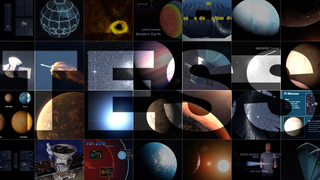Universe
ID: 13510
Researchers working with data from NASA’s Transiting Exoplanet Survey Satellite (TESS) have discovered the mission’s first circumbinary planet, a world orbiting two stars. The planet, called TOI 1338 b, is around 6.9 times larger than Earth, or between the sizes of Neptune and Saturn. It lies in a system 1,300 light-years away in the constellation Pictor.
The stars in the system make an eclipsing binary, which occurs when the stellar companions circle each other in our plane of view. One is about 10% more massive than our Sun, while the other is cooler, dimmer and only one-third the Sun’s mass.
TOI 1338 b’s transits are irregular, between every 93 and 95 days, and vary in depth and duration thanks to the orbital motion of its stars. TESS only sees the transits crossing the larger star — the transits of the smaller star are too faint to detect. Although the planet transits irregularly, its orbit is stable for at least the next 10 million years. The orbit’s angle to us, however, changes enough that the planet transit will cease after November 2023 and resume eight years later.
TESS Satellite Discovered Its First World Orbiting Two Stars
The stars in the system make an eclipsing binary, which occurs when the stellar companions circle each other in our plane of view. One is about 10% more massive than our Sun, while the other is cooler, dimmer and only one-third the Sun’s mass.
TOI 1338 b’s transits are irregular, between every 93 and 95 days, and vary in depth and duration thanks to the orbital motion of its stars. TESS only sees the transits crossing the larger star — the transits of the smaller star are too faint to detect. Although the planet transits irregularly, its orbit is stable for at least the next 10 million years. The orbit’s angle to us, however, changes enough that the planet transit will cease after November 2023 and resume eight years later.
Used Elsewhere In
Credits
Chris Smith (USRA): Lead Producer
Chris Smith (USRA): Lead Animator
Jeanette Kazmierczak (University of Maryland College Park): Lead Science Writer
Chris Smith (USRA): Writer
Veselin Kostov (NASA Postdoctoral Fellow): Scientist
Francis Reddy (University of Maryland College Park): Science Writer
Chris Smith (USRA): Lead Animator
Jeanette Kazmierczak (University of Maryland College Park): Lead Science Writer
Chris Smith (USRA): Writer
Veselin Kostov (NASA Postdoctoral Fellow): Scientist
Francis Reddy (University of Maryland College Park): Science Writer
Please give credit for this item to:
NASA's Goddard Space Flight Center
NASA's Goddard Space Flight Center
Short URL to share this page:
https://svs.gsfc.nasa.gov/13510
Mission:
TESS
This item is part of these series:
Narrated Movies
Astrophysics Features
Keywords:
SVS >> HDTV
SVS >> Transit
SVS >> Astrophysics
SVS >> Planets
SVS >> Space
SVS >> Eclipse
SVS >> Binary Star
SVS >> Star
NASA Science >> Universe
SVS >> Exoplanet
SVS >> TESS
SVS >> Circumbinary
https://svs.gsfc.nasa.gov/13510
Mission:
TESS
This item is part of these series:
Narrated Movies
Astrophysics Features
Keywords:
SVS >> HDTV
SVS >> Transit
SVS >> Astrophysics
SVS >> Planets
SVS >> Space
SVS >> Eclipse
SVS >> Binary Star
SVS >> Star
NASA Science >> Universe
SVS >> Exoplanet
SVS >> TESS
SVS >> Circumbinary












